Approved by Dr. Luqman Javed
Caring for baby chickens can be a daunting task. This is especially true if you’re new to the world of raising chicks, hens, and roosters. Luckily, with a little understanding, great info, and love for nurturing healthy baby chickens are possible.
If you’ve started your journey into the world of chickens with hens, then they will take on the responsibility of raising their young themselves. In most scenarios, that is. If you have decided to start this journey fresh, then most likely you’ve chosen your baby chicks from a hatchery. Once your baby chickens arrive, you’ll be asking yourself tons of questions. How often should they be fed? What temperatures are best for keeping them comfortable? And most importantly, when can baby chickens go outside and truly begin their lives?
Though chicks can transition to an outdoor coop life once they are 4 to 6 weeks old, a great deal of work is required before they’re ready for this milestone. In this article, we’ll break down the fundamentals of caring for your chicks from when they first arrive to when they can be housed outdoors.

Chicks are a full time task and not easy to raise. The process might also involve heartbreak along the way. If you’re new to keeping chicks, it might be best to adopt a broody hen, or a hen with a confirmed broody history, and have her incubate eggs to raise chicks. Under the care of a broody hen, many burdens will be eased off your shoulders.
The rest of this article will discuss the care steps for chicks without a hen; however, the option to have a broody hen raise chicks is extremely useful and shouldn’t be discounted.
The Day Your Baby Chickens Arrive
Some hatcheries are willing to ship baby chicks straight to your home. This is a good way to welcome new additions to your family. If you don’t have a local hatchery, then you’ll find yourself waiting a few days after you’ve made your initial order. Regardless of where you source your chicks from, it is important to have everything ready before they arrive.
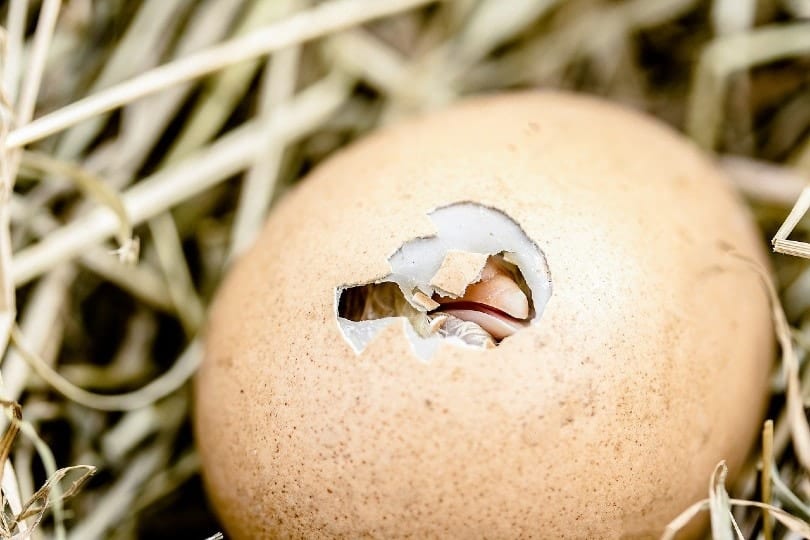
The Brooder
Having a brooder ready when your baby chickens arrive is crucial. This is where your baby chicks will stay for the first few weeks of their life. The amount of room required to keep your new chicks depends on how many you’ve decided to bring home. Most hatcheries recommend ½ square foot per chick. For example, if you’ve adopted a dozen chicks, consider 6 square inches of brooder (that is, a brooder that measures 6 feet on each side).
A brooder can be made from several different objects. The important things to remember are proper ventilation, heat, humidity, and protection from drafts and cold. Many people choose to use a cardboard box with ventilation holes in it. Though inexpensive, such a setup does prove challenging to keep warm at times. It also doesn’t last long through multiple cleanings.
Others prefer to use kiddie pools. Storage bins with proper ventilation are another DIY option. Whichever brooder you choose will work, just remember to have it ready and warmed up before the chicks arrive.
Keeping Babies Warm
Baby chicks are covered with fluffy feathers known as down feathers. Though these feathers do offer them some protection from the elements, chicks are not able to properly manage temperatures that are too cold. Broody hens often settle down and allow chicks to hide under their feathers for extra warmth. In the absence of a hen, this task falls on you and can be accomplished by controlling the temperature of the brooder.
In their first few days of life, a chick requires temperatures around 95°F (35°C). With each week they age, you can lower the temperature by 5 °F. Once chicks are around 4 weeks old, they are usually able to thermoregulate well but might still need a brooder’s assistance at night when temperatures tend to drop.
Choosing the right heat source isn’t too difficult of a task. Commercial brooders often come with a heating element and replacement bulbs. For DIY projects, a heat source can be purchased from your hatchery or a pet store.
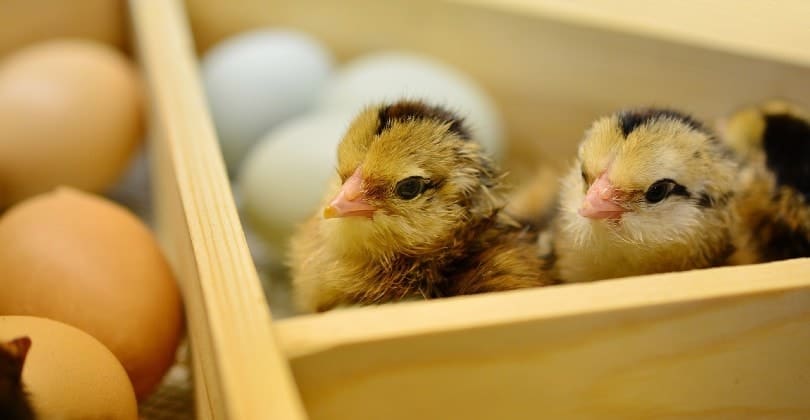
Bedding
Chicks need their brooder to have appropriate bedding materials. These materials must be absorbent or you’re in for a rough time. You’ll also be completely refreshing this bedding roughly once a week, while doing partial replacements on a daily basis. Keep plenty on hand so you’re ready when your chicks need a clean brooder.
Baby chickens use the potty frequently. Absorbent materials like aspen shavings or spread pine are great at absorbing their movements while also being gentle on their feet. When changing out your shavings, using paper towels is also a smart idea. They are very absorbent and work well in a pinch.
A word of advice when it comes to shavings, however. Most breeders and hatcheries recommend that you steer clear of cedar shavings. The aromatic oils in these shavings can cause your baby chickens breathing issues as they grow. In addition, you should avoid scented shavings or absorbent materials meant for other species (for example, some cat litters are harmful for chicks).
Feeders and Waterers
Baby chickens can be little rascals. You’ll find them kicking out their shavings and making messes while they frolic and play. Without the proper feeders and waterers, you’ll also find them spilling their food and water all over the place.
You’ll spend more money trying to keep your chicks fed if you don’t use proper equipment. Great feeders and waterers have small holes for your chickens to peck through. This helps control the mess; however, you should still encourage your chicks to forage and scratch by offering them some feed in their substrate, as foraging is considered natural for chicks. Ensure the feeders you use for your chicks have a lip low enough for your chicks to comfortably eat.
Feed
To get your chicken off on the right foot when it comes home, you need starter feed. Similar to puppy and kitten food, starter feed is specially balanced with everything your chick needs to grow well. Each manufacturer of these starter feeds combines different things in their formula. Choose the brand and formula you feel most comfortable with then stick with it.
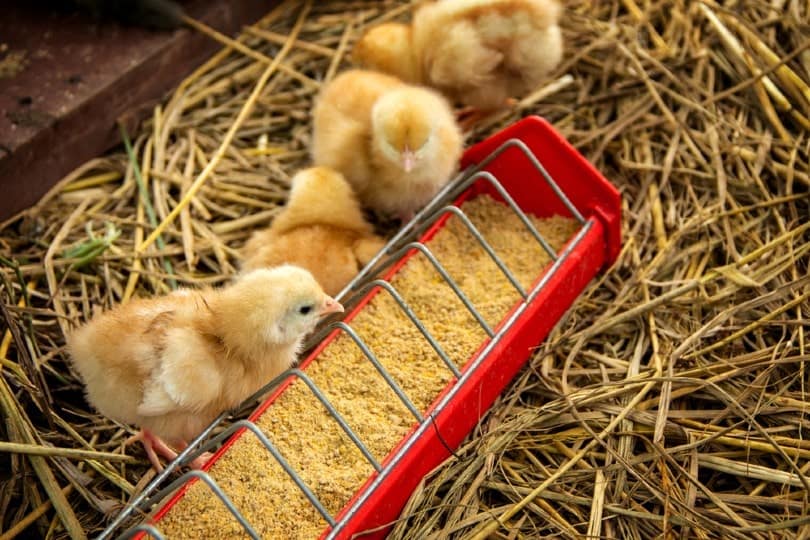
Netting
According to the depth of your breeder, you may need netting on top to keep your chicks safely inside. Chicks usually have well-developed wings by the time they are around 10 days old. Though they don’t exactly fly, their wings help them hop and clear obstacles. If the sides of your brooder are not high enough, your chick may inadvertently jump out. Chicken wire and deer netting make great coverings for your brooder. This keeps chicks inside and safe even when you aren’t with them.
The Arrival
If you’ve ordered your chicks from a hatchery where delivery is required, be aware of when your chicks are coming. The last thing you want is to lose all your babies thanks to the lack of proper heat during shipping. That part can be heartbreaking.
Whether your chicks were bought locally or being shipped, getting them into their brooder immediately is a smart plan. They’ll have access to clean water and fresh feed. Be ready to nurse any chicks who act under the weather. They won’t necessarily be sick, but the trip from their hatchery to your home can be stressful.
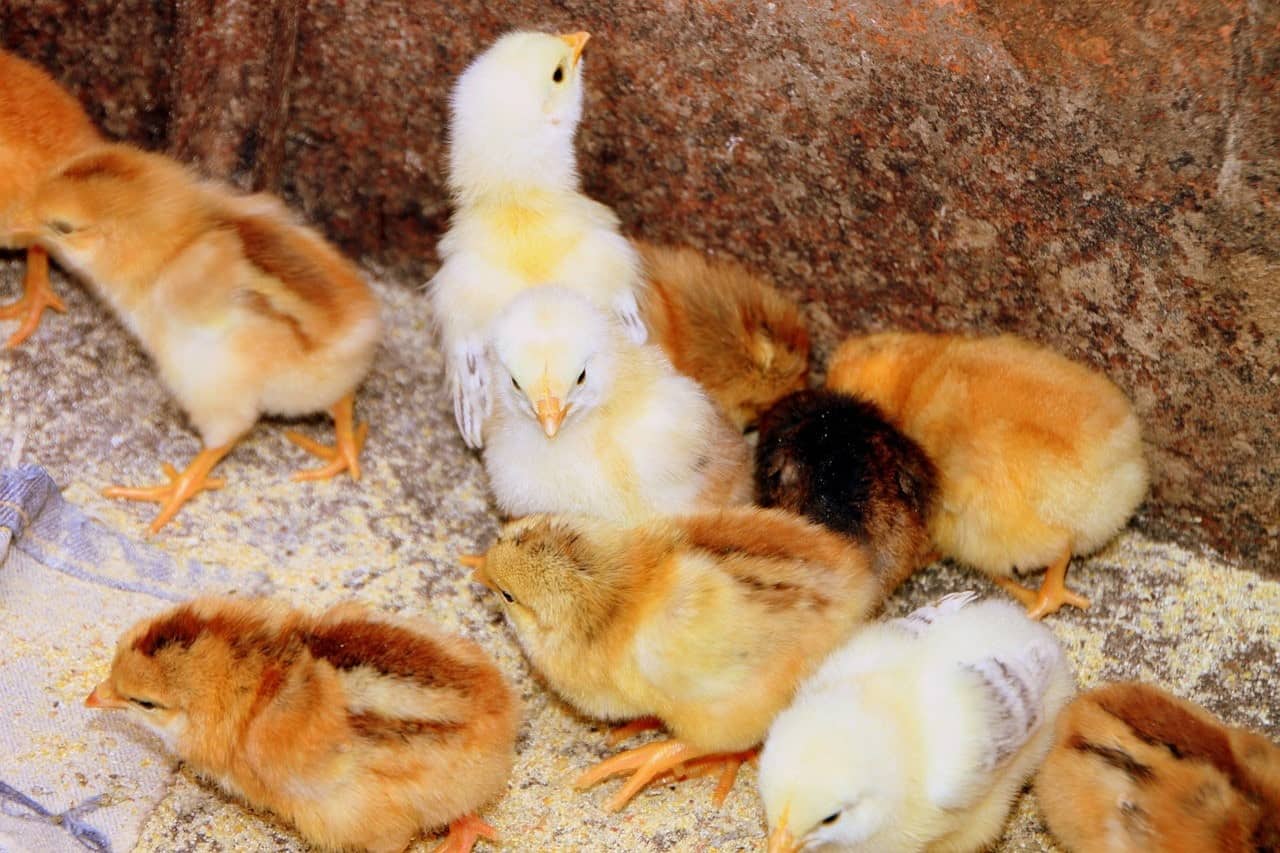
Caring for Your Chicks
Yes, this process is never-ending. Your baby chickens will need lots of attention to grow up healthy. Unlike some other animals, they can self-regulate. This means they will stop eating when they are full. Keep fresh feed always available so they can eat all they need. The same can be said for their water. It must be fresh and clean to avoid issues with illnesses.
Heat is one of the most important parts of raising baby chickens. If you noticed they are huddled near the heat source in a group, most likely, their home isn’t warm enough. If they are staying away from the heat source, and one another, they are too warm. Keep a close eye on all of this so your chicks can make the transition to life outside without issue.
Your chicks should be placed in their brooder for a period of about 4 to 6 weeks.

Preparing for Life Outdoors
At 4 to 6 weeks of age, most baby chickens are ready for life outside. Before they can make this adjustment, however, a chicken coop must be purchased. Make sure any coop you buy for your baby chickens is predator and rodent-proof. These are the last things you’ll want inside with your chickens. DIY coops are possible as well; however, extra precautions are necessary to ensure that they are escape and predator-proof.
The inside of your coop should also provide adequate roosting poles and nesting areas for hens. Using ladders helps your hens reach their roosts or boxes when they are ready to use them. Your female chicks may lay eggs once they are old enough. Though hens may share nesting boxes, it’s best to offer them plenty of extra options, as some individuals can get very feisty when it comes to laying eggs.
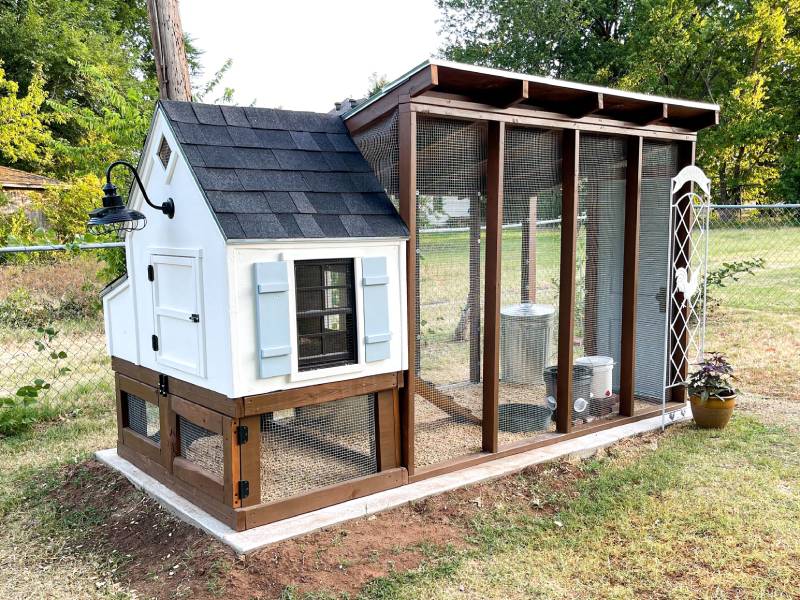
The World Outside
Yes, once all this is prepared and your baby chickens are at least 4 to 6 weeks old, they are ready to live life in their chicken coops and your yard. It is best to keep your juvenile chicks in a coop that is covered and has a covered run. This allows them to explore the outdoors and safely forage without being attacked by predators. Though predators are a risk for all free-ranging chickens, juveniles and chicks are at much higher risk, and therefore, the extra security is definitely warranted.
Allow your chicks to adjust to their coop and their new environment for a few weeks before allowing them to free-range outside the coop (if you choose to house free-ranging birds). It is important to have extra precautions against predators for free-range chickens. Examples include guard dogs, appropriate fences, and nets. Most chicken keepers advise against allowing chickens to free-range, as this may lead to a loss of a beloved pet to a predator.
Though chicks are able to thermoregulate by the time they are around 6 weeks old, it is best to transition them to an outdoor life during spring and summer. The harsh winds and unpredictable weather of autumn and winter might be too much for a juvenile chick to handle. If you live in a particularly cold area, you might have to offer your chicks a source of warmth within their coop. Examples include appropriately installed heating fixtures or a thermo chicken perch.

In Conclusion
Raising baby chickens is difficult but can be very rewarding. Providing the love and care these little creatures need to grow up and be healthy, productive chickens can make any breeder proud. The weeks you spend preparing your babies for life outside will give them all the tools they need to survive on their own. You’ll be a proud chicken parent and reap the rewards your hard work provides.
Featured Image Credit: PCHT, Shutterstock
